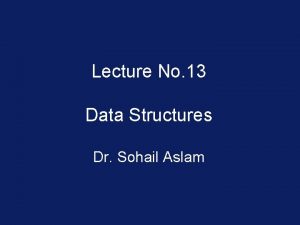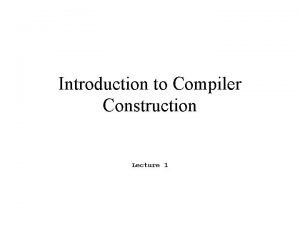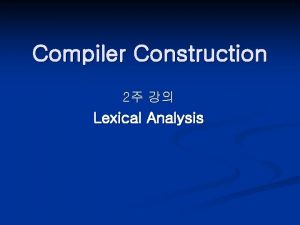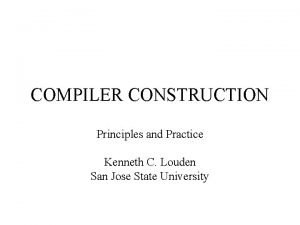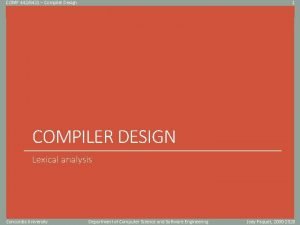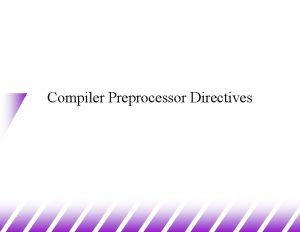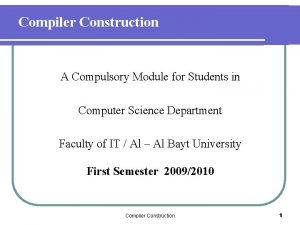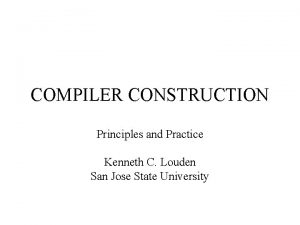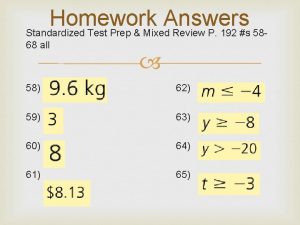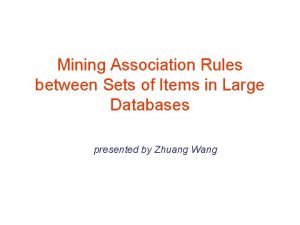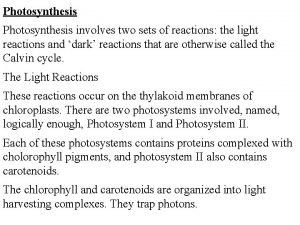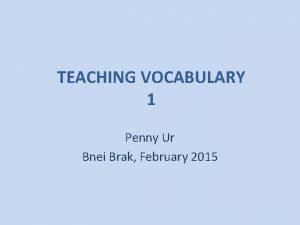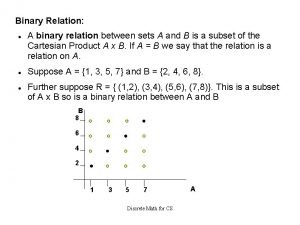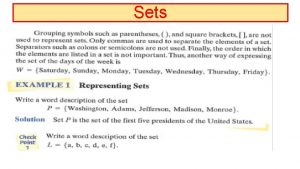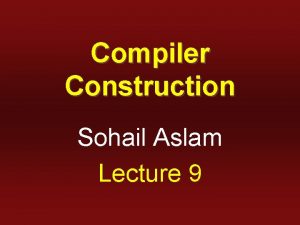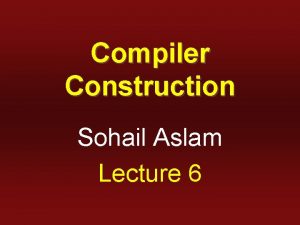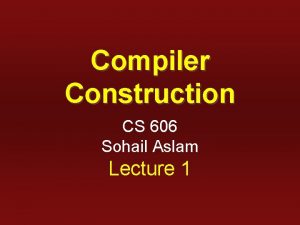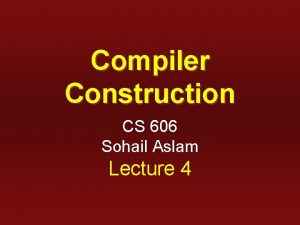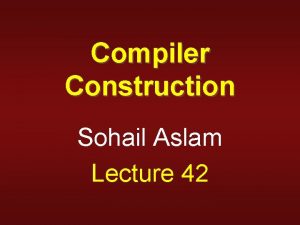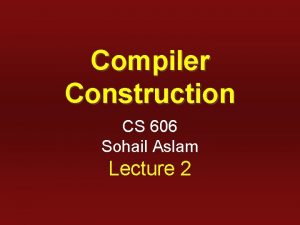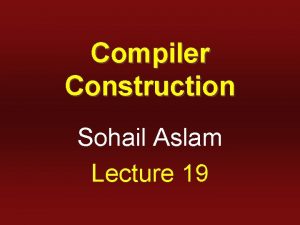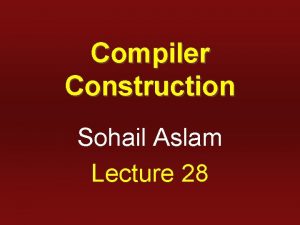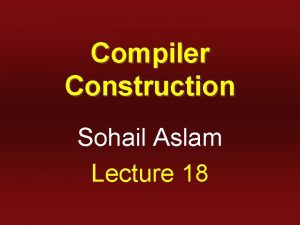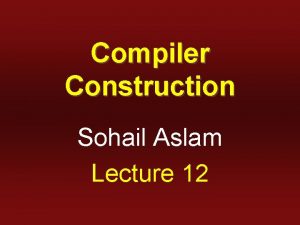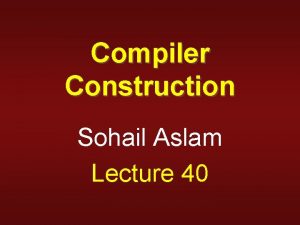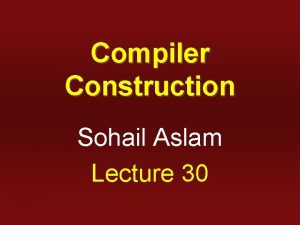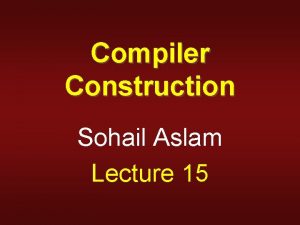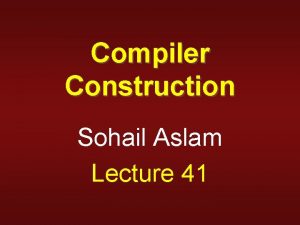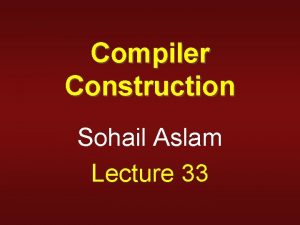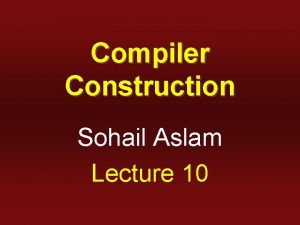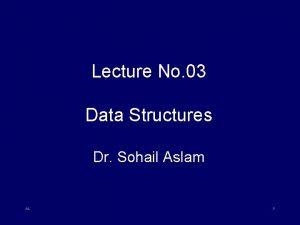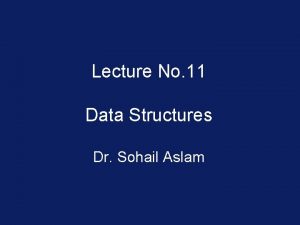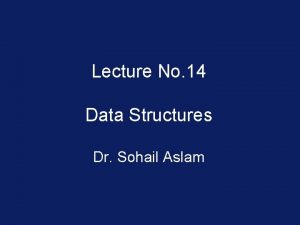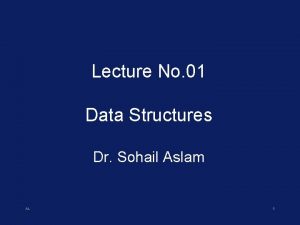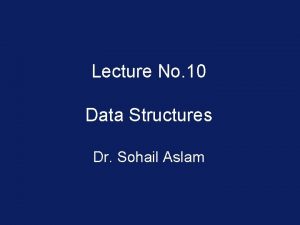Compiler Construction Sohail Aslam Lecture 25 Sets of

![Sets of LR(1) Items I 0 ={ [S → E, $], [E → E+(E), Sets of LR(1) Items I 0 ={ [S → E, $], [E → E+(E),](https://slidetodoc.com/presentation_image_h2/018cbf188a687a16baf03a8f9ba11a19/image-2.jpg)
![The Closure Procedure Rationale: § if [A → b Cd, a] s, then one The Closure Procedure Rationale: § if [A → b Cd, a] s, then one](https://slidetodoc.com/presentation_image_h2/018cbf188a687a16baf03a8f9ba11a19/image-3.jpg)





![The goto Procedure § A state s that contains [X → a yb, b] The goto Procedure § A state s that contains [X → a yb, b]](https://slidetodoc.com/presentation_image_h2/018cbf188a687a16baf03a8f9ba11a19/image-9.jpg)
![goto(s, y) m {} for each item [X → a yb, b] s m goto(s, y) m {} for each item [X → a yb, b] s m](https://slidetodoc.com/presentation_image_h2/018cbf188a687a16baf03a8f9ba11a19/image-10.jpg)















- Slides: 25

Compiler Construction Sohail Aslam Lecture 25
![Sets of LR1 Items I 0 S E E EE Sets of LR(1) Items I 0 ={ [S → E, $], [E → E+(E),](https://slidetodoc.com/presentation_image_h2/018cbf188a687a16baf03a8f9ba11a19/image-2.jpg)
Sets of LR(1) Items I 0 ={ [S → E, $], [E → E+(E), $/+], [E → int, $/+] } 2
![The Closure Procedure Rationale if A b Cd a s then one The Closure Procedure Rationale: § if [A → b Cd, a] s, then one](https://slidetodoc.com/presentation_image_h2/018cbf188a687a16baf03a8f9ba11a19/image-3.jpg)
The Closure Procedure Rationale: § if [A → b Cd, a] s, then one potential completion for the left context is to find a string that reduces to C, followed by da 3

The Closure Procedure § This completion should cause a reduction to A, since it fills out the production’s righthand side (Cd), and follows it with a valid lookahead symbol 4

The Closure Procedure § For a production C → g, closure must insert ' ' before g and add appropriate lookahead symbols – all terminals that can appear as the initial symbol in da 5

The Closure Procedure § This includes every terminal in FIRST(d). If e FIRST(d), it also includes a, thus FIRST(da) in the algorithm 6

The goto Procedure § The second critical step in the construction is to derive other parser states from I 0 7

The goto Procedure § To accomplish this, we compute, for each state Ii and each grammar symbol y, the state that would arise if the parser recognized an y while in state Ii 8
![The goto Procedure A state s that contains X a yb b The goto Procedure § A state s that contains [X → a yb, b]](https://slidetodoc.com/presentation_image_h2/018cbf188a687a16baf03a8f9ba11a19/image-9.jpg)
The goto Procedure § A state s that contains [X → a yb, b] has a transition (goto) labeled y to the state that contains the items goto(s, y) • y can be terminal or a nonterminal 9
![gotos y m for each item X a yb b s m goto(s, y) m {} for each item [X → a yb, b] s m](https://slidetodoc.com/presentation_image_h2/018cbf188a687a16baf03a8f9ba11a19/image-10.jpg)
goto(s, y) m {} for each item [X → a yb, b] s m ← m {[X → ay b, b]} return closure(m) 10

Finite Automaton of Items § The LR(1) items are used as the states of a finite automaton that maintains information about the parsing stack and progress of a shiftreduce parser 11

Finite Automaton of Items § This will start out as a nondeterministic finite automaton (NFA) § The DFA can be constructed from this NFA using the subset construction, similar to one we used for lexical analysis 12

Finite Automaton of Items § This will start out as a nondeterministic finite automaton (NFA) § The DFA can be constructed from this NFA using the subset construction, similar to one we used for lexical analysis 13

Finite Automaton of Items § What are the transitions of the NFA of LR(0) items? § Consider the item A→ a g § Suppose g begins with symbol X which may be a terminal (token) or non-terminal 14

Finite Automaton of Items § What are the transitions of the NFA of LR(0) items? § Consider the item A→ a g § Suppose g begins with symbol X which may be a terminal (token) or non-terminal 15

Finite Automaton of Items § What are the transitions of the NFA of LR(0) items? § Consider the item A→ a g § Suppose g begins with symbol X which may be a terminal (token) or non-terminal 16

Finite Automaton of Items § The item can be written as A→ a Xh § Then there is a transition on symbol X for state represented by item A→ a Xh to state represented by item A→ a. X h 17

Finite Automaton of Items § The item can be written as A→ a Xh § Then there is a transition on symbol X for state represented by item A→ a Xh to state represented by item A→ a. X h 18

Finite Automaton of Items A → a Xh X A → a. X h 19

Finite Automaton of Items A → a Xh X A → a. X h If X is a terminal, then this transition corresponds to a shift of X from input to top of parse stack 20

Finite Automaton of Items A → a Xh X A → a. X h If X is a non-terminal, then the interpretation of this transition is more complex because nonterminals donot appear in input 21

Finite Automaton of Items A → a Xh X A → a. X h In fact, such a transition will correspond to pushing of X onto the stack during the parse 22

Finite Automaton of Items A → a Xh X A → a. X h But this can only occur during a reduction by the production X → b 23

Finite Automaton of Items A → a Xh X A → a. X h Such a reduction must be preceded by recognition of a b 24

Finite Automaton of Items A → a Xh X A → a. X h The state given by X → b represents the beginning of this process (dot indicates we are about to recognize b) 25
 Dr sohail aslam
Dr sohail aslam Dr sohail lectures
Dr sohail lectures Aslam anis
Aslam anis Dian laundry
Dian laundry Aslam has to study four books
Aslam has to study four books Yacc tutorial
Yacc tutorial Cross compiler in compiler design
Cross compiler in compiler design If the lexical analyzer finds a token invalid then?
If the lexical analyzer finds a token invalid then? Advantages and disadvantages of interpreter and compiler
Advantages and disadvantages of interpreter and compiler Front end of a compiler
Front end of a compiler Lexical analysis
Lexical analysis Compiler construction: principles and practice
Compiler construction: principles and practice Front end phases of compiler
Front end phases of compiler Thompson construction in compiler design
Thompson construction in compiler design Static and dynamic type checking in compiler design
Static and dynamic type checking in compiler design Preprocessor in compiler construction
Preprocessor in compiler construction Machine independent code optimization
Machine independent code optimization Compiler
Compiler 01:640:244 lecture notes - lecture 15: plat, idah, farad
01:640:244 lecture notes - lecture 15: plat, idah, farad 4ps of project management
4ps of project management 3-5 practice working with sets form g answer key
3-5 practice working with sets form g answer key Sets of items
Sets of items Almost essential
Almost essential What are the 2 sets of reactions in photosynthesis
What are the 2 sets of reactions in photosynthesis Lexical sets
Lexical sets Binary relation between two sets
Binary relation between two sets
